Located in Delaplane, Virginia, less than an hour away from the nation’s capital, Hidden Creek Farm, LLC is built around the principles of regenerative agriculture. Founders Dendy and Andrea Young believe first and foremost in the stewardship of the land and in the concept that good food and a clean environment will keep people and animals healthy, resilient, and energized. The farm offers beef, pork, lamb, turkey, eggs, produce, honey, and a variety of specialty products to consumers, as well as providing breeding and feeder stock to farmers. The farm also owns and operates Red Polls USA, a group dedicated to breeding Red Poll cattle, a threatened heritage breed with a unique genetic “superpower.”
How did you get into farming?
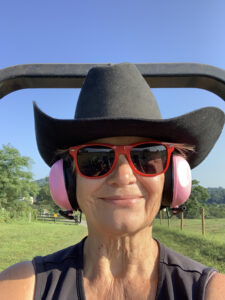 Well, I had always wanted some sort of a farm. I love the feeling of being connected to our living, breathing earth. But family, jobs, and life-needs in general did not line up with farming for a very long time. About seven years ago my husband Dendy and I started talking about what we wanted our legacy in life to be. Both of us believe passionately in stewardship of land and the things we cherish: family, friends, community, healthy food, nature, environment, curiosity, and meaningful connection. We decided that building a farm that nourished all of these things would indeed be a worthwhile endeavor.
Well, I had always wanted some sort of a farm. I love the feeling of being connected to our living, breathing earth. But family, jobs, and life-needs in general did not line up with farming for a very long time. About seven years ago my husband Dendy and I started talking about what we wanted our legacy in life to be. Both of us believe passionately in stewardship of land and the things we cherish: family, friends, community, healthy food, nature, environment, curiosity, and meaningful connection. We decided that building a farm that nourished all of these things would indeed be a worthwhile endeavor.
In 2015 we purchased the original 250 acres of our farm. The farm was listed for way over our budget. We had fallen in love with the tangled bit of land and collapsing buildings, however, so we decided to make the best offer we could afford. Just 24 hours later we owned a farm. I tell people that we did not decide to farm or find our farm. Instead, our farm decided it would call us into its service.
We dove in head-first. Luckily, I believe, we really had no clue as to what farming would actually require of us! Also luckily, we farm in Fauquier County, VA, which has incredibly talented, generous, and dedicated extension, farm service, and government agency specialists and a generous environmentally and health-conscious community. This wonderful support system has been critical in helping us build our legacy.
Hidden Creek Farm is both USDA Certified Organic and Certified Humane. Even though most small farms follow organic and ethical practices, relatively few obtain these official certifications. Why did you decide to go this route?
Most of our customers are both very health conscious and very concerned about how their animals and produce is raised or grown. And so are we. It is important for us to communicate to our customers and suppliers that we are committed to supporting their needs and convictions. We initially went through both the humane and organic certification processes with the help of a large customer who was purchasing our livestock and required us to provide organic and humane certified animals. That customer has since closed shop, but we elected to keep the certifications active because we believe they communicate our practices and because they provide a great springboard for deeper conversations and learning.
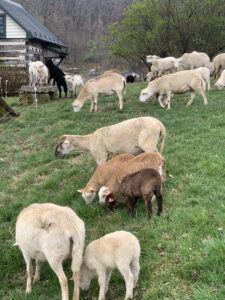 Certified Humane was a no-brainer for me. The humane treatment of all living creatures is a core tenet of who we are, both as farmers and as individuals. Certified Organic is a more nuanced and complicated matter. It is relatively easy, although labor intensive, to grow produce as a Certified Organic farmer. It is far more difficult to raise some livestock as a Certified Organic farmer. First of all, there is the philosophical dilemma. Organic farm practices on a farm really don’t say much about the quality of life of the animal. Organic simply says that what goes on the animal, into the animal, and what the animal lives/sleeps on is free of certain chemicals and compounds. So, one could conceivably use organic practices and still not treat the animal in a humane fashion.
Certified Humane was a no-brainer for me. The humane treatment of all living creatures is a core tenet of who we are, both as farmers and as individuals. Certified Organic is a more nuanced and complicated matter. It is relatively easy, although labor intensive, to grow produce as a Certified Organic farmer. It is far more difficult to raise some livestock as a Certified Organic farmer. First of all, there is the philosophical dilemma. Organic farm practices on a farm really don’t say much about the quality of life of the animal. Organic simply says that what goes on the animal, into the animal, and what the animal lives/sleeps on is free of certain chemicals and compounds. So, one could conceivably use organic practices and still not treat the animal in a humane fashion.
In addition, it is incredibly difficult and expensive to purchase Certified Organic feed in our area for our chickens and pigs, especially in bulk and in a form that is both high enough in protein and low in waste. Add to that our commitment to offer our customers a soy-free product and it becomes a real struggle to find feed that meets Certified Organic criteria. Since our ruminants are 100% grass- and forage-fed, we are able to certify our cattle and sheep as organic using organic-certified pastures and removing any animals we have to treat from the organic harvest, but we may have to move to a non-GMO structure for our layers and pigs going forward.
What enrichment opportunities are available for visitors to the farm?
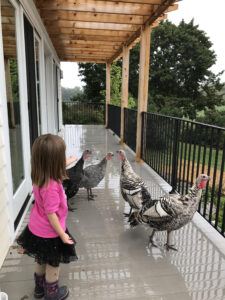 Hidden Creek Farm is dedicated to connecting the consumer and visitor with food and farming. One key differentiator is that we practice innovative, science-based farming, so our focus is on improvement of soils, livestock, and production based on science and experimentation. We are constantly pushing the edges of knowledge and processes. A bit more nerdy than the average farm, I suppose, but incredibly stimulating and exciting. Our goal is to “reset” expectations of how food is grown, what it takes to farm, and the science behind farming in a conscientious and eco-reverent manner.
Hidden Creek Farm is dedicated to connecting the consumer and visitor with food and farming. One key differentiator is that we practice innovative, science-based farming, so our focus is on improvement of soils, livestock, and production based on science and experimentation. We are constantly pushing the edges of knowledge and processes. A bit more nerdy than the average farm, I suppose, but incredibly stimulating and exciting. Our goal is to “reset” expectations of how food is grown, what it takes to farm, and the science behind farming in a conscientious and eco-reverent manner.
We offer produce CSA programs and protein options to customers, either delivered, on-farm, or at farmers markets. We provide individualized tours to all ages and for all backgrounds, including other farmers. We offer internships and volunteer opportunities, as well as Experiential Learning workshops and farm stays. As a diversified farm, we can tailor experiences to each visitor’s interests around produce, soil management, rotational grazing, pasture management, beekeeping, and many other aspects of farming. We also employ at least one student or recent student each year to lead a research project in search of new scientific knowledge. This year we are focusing on soil and nutrient development. Finally, we are committed to supporting other farmers either as mentors or by breeding quality replacement seed stock and finishing stock for their farms.
Regenerative agriculture is a big part of Hidden Creek Farm’s mission. What exactly does this entail?
The Miriam-Webster dictionary definition of regenerate suggests three meanings: “formed or created again”; “spiritually reborn or converted”; “restored to a better, higher, or more worthy state”. All three definitions are relevant to how we farm at Hidden Creek Farm. My first real connection with the concepts of regenerative farming came through Future Harvest CASA. I fell in love with the concept of regeneration and the support for farmers trying to reconnect food to consumer while building a sustainable “foodshed”.
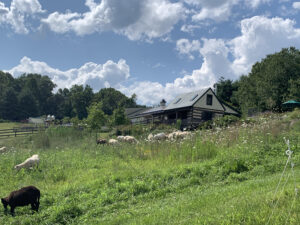 Regenerative farmers usually believe, in short, that the soil is the most valuable asset on earth and that it must be nurtured like the living, teaming collection of organisms it is. Everything above the soil is a manifestation of the health and vibrancy of what exists beneath the soil. Deep, healthy soils hold water like a sponge, keeping pastures growing even during drought. Deep, healthy soils grow dense, diverse plants which, in turn, capture atmospheric carbon through photosynthesis and sequester it in their roots. Some farmers believe in the “sun-down” model, where the sun is responsible for creating all energy and life. I believe in the “soil-up, sun-down” model, where the sun and our earthly soils work in unison to create and sustain life. This is why we try not to disrupt the soil in our pastures. This is why we do not use pesticides on our farm. This is why we use rotational grazing with three different species (cattle, sheep, chickens) to naturally return nutrients to the pastures. This is why we try never to take energy off the pastures. This is why everything we do is focused on improving the soil on our farm.
Regenerative farmers usually believe, in short, that the soil is the most valuable asset on earth and that it must be nurtured like the living, teaming collection of organisms it is. Everything above the soil is a manifestation of the health and vibrancy of what exists beneath the soil. Deep, healthy soils hold water like a sponge, keeping pastures growing even during drought. Deep, healthy soils grow dense, diverse plants which, in turn, capture atmospheric carbon through photosynthesis and sequester it in their roots. Some farmers believe in the “sun-down” model, where the sun is responsible for creating all energy and life. I believe in the “soil-up, sun-down” model, where the sun and our earthly soils work in unison to create and sustain life. This is why we try not to disrupt the soil in our pastures. This is why we do not use pesticides on our farm. This is why we use rotational grazing with three different species (cattle, sheep, chickens) to naturally return nutrients to the pastures. This is why we try never to take energy off the pastures. This is why everything we do is focused on improving the soil on our farm.
It is truly impossible to live and work so intimately with the land without feeling spiritually nourished and reborn. I like to say we watch and hear the farm breathe, and are better for it. She is a living organism that cares for us just as we care for her.
Hidden Creek Farm raises its own trademarked breed of pig — can you tell me more about that?
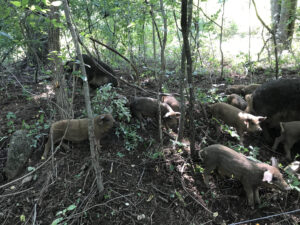 We set ourselves a couple of goals when we first started raising pigs: First, they had to thrive on pasture 365 days a year, with minimal portable shelter and temperatures ranging between close to 0 degrees Fahrenheit in the winter and 104 degrees Fahrenheit in the summer. Second, they had to be easy to work with since we administer iron shots and castrate piglets in the field. Third, they had to be able to navigate our hilly local Piedmont terrain while balancing meat and fat distribution. Fourth, they had to be able to protect themselves and their young against predators and be resistant to disease. And finally, they had to taste amazing.
We set ourselves a couple of goals when we first started raising pigs: First, they had to thrive on pasture 365 days a year, with minimal portable shelter and temperatures ranging between close to 0 degrees Fahrenheit in the winter and 104 degrees Fahrenheit in the summer. Second, they had to be easy to work with since we administer iron shots and castrate piglets in the field. Third, they had to be able to navigate our hilly local Piedmont terrain while balancing meat and fat distribution. Fourth, they had to be able to protect themselves and their young against predators and be resistant to disease. And finally, they had to taste amazing.
Little did I know the challenge we had posed ourselves! We bought our first pigs from a local farmer who raised them on pasture. The Duroc/Hampshire cross was a pretty solid choice, but we were only able to acquire feeder stock (animals that we raised up for harvest) since he would not sell us breeding stock. So, we decided to research the “ideal” pig and breed our own proprietary passel of pigs. We wanted something closely related in flavor to the Iberian pig, passive and friendly, with great farrowing and maternal instincts, hirsute so it could deal with temperature fluctuations, big enough to stand up to bear and coywolves, and able to retain fat in challenging environments. My mother grew up in Hungary and suggested the Mangalitsa lard breed as one option. Her family had always kept one or two of these pigs to stock their larder. I had always liked the idea of raising heritage Tamworth pigs, which had been introduced to America by early settlers from the British Isles. In my enthusiastic ignorance, we hit upon a mix which is truly exceptional in all ways: Fabulous meat, easy to manage on pasture, and consistently productive. So the Tamalitsa™ breed was born.
You raise Red Poll cattle and started Red Polls USA. What makes this breed so special?
Ah, Red Poll cattle. What an amazing, undiscovered breed! Hidden Creek Farm now is, I believe, one of the more significant breeders of Red Polls in the United States, and certainly on the East Coast.
When I was originally looking for cattle, I wanted something different from the black angus that ubiquitously dot our Virginia pastures. I had a few “simple” criteria:
- No horns. I do not like horns on the farm. They are unsafe to humans and other animals and they tear down fences.
- Dual-purpose breed. I wanted our cattle to be able, if needed, to supply both meat and high-quality milk.
- Easy to work with. I don’t like being charged, butted, stomped at, etc. I wanted friendly, kind cows and bulls.
- Great mothers. I was terrified after reading cattle literature about having to wrap chains around calves’ legs in utero and pulling them out of the cow, or cows abandoning their calves and having to bottle feed calves. This is not how I want to spend my time on the farm! Plus, it seems inhumane to all involved. So, whatever breed we committed to had to be able to take care of birthing and calf care pretty much on its own.
- Great on grass. Our commitment is that all of our livestock have to survive on pasture. I needed cattle that were shorter, rounder, and able to convert forage to protein without additional feed or intervention on my part.
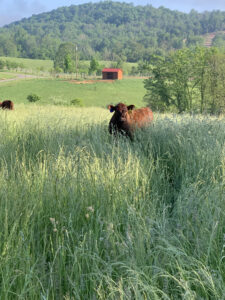 Fortunately I stumbled upon The Livestock Conservancy and, voila! There were my cows: gorgeous, auburn, threatened, potatoes-on-toothpicks cows … the Red Poll.
Fortunately I stumbled upon The Livestock Conservancy and, voila! There were my cows: gorgeous, auburn, threatened, potatoes-on-toothpicks cows … the Red Poll.
Subsequently I heard a rumor that a researcher was doing work on Salmonella resistance in cattle. This was fascinating to me, as Salmonella poses massive threats to both the food system and to livestock. After a lot of digging, I tracked down the researcher and offered our Red Polls as subjects for genetic testing. He tested close to 90 of our animals for his research and compared them to several other breeds in order to determine frequency of the specific resistant gene expression. A third of our Hidden Creek Farm herd tested positive for the SNP (single nucleotide polymorphism) on the genes responsible for Salmonella resistance! In addition, they also tested positive for E. coli resistance!
This is pretty exciting news, especially as no black-hided animals show either Salmonella or E. coli resistance to date. It appears that the SNPs on the relevant genes are inactivated by the color-coding for black. Now, I am not a scientist, so I cannot explain the intricate details of the testing, but I did immediately understand the potential implications of these findings on both cattle operations and food safety processes. Hidden Creek Farm is actively and intensively breeding for Red Poll cattle that are wholly Salmonella and E. coli resistant. We expect our entire herd to meet these criteria by 2023.
What role do you see for heritage breeds like the Red Poll in the future of agriculture?
We humans are so quick to rush through the world and leave a path of destruction in our wake. As we erase scientific treasures in our “paving-over-for-progress” world, we are, I am convinced, erasing scientific and biological treasures inherent in our heritage breeds as they slowly disappear from our livestock caches.
Red Poll cattle, like many heritage breeds, evolved over centuries in concert with both humans and their environment. Unlike our modern-day commercial breeds, heritage breeds survived on pasture and local forage. Pre-industrialized farmers did not have access to grain deliveries, storage, supermarkets, etc. They had access to their land and what the land grew. If they did not care for it, it could not care for them. Simple as that. Life was tough, predictably unpredictable, and relentless. Heritage breeds developed to survive in that same environment.
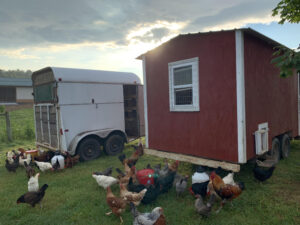 Commercial agriculture threw most of these original breeds out when farming became focused on mass production and low cost. Health, quality, and slow growth were, and are, incompatible with a quick turnover of large, highly marbled, highly grain-fed animals. Bigger, faster, cookie-cutter is what agriculture was looking for in order to meet customer demand for inexpensive food anywhere, everywhere, and at the drop of a hat.
Commercial agriculture threw most of these original breeds out when farming became focused on mass production and low cost. Health, quality, and slow growth were, and are, incompatible with a quick turnover of large, highly marbled, highly grain-fed animals. Bigger, faster, cookie-cutter is what agriculture was looking for in order to meet customer demand for inexpensive food anywhere, everywhere, and at the drop of a hat.
In the long term, this is not a healthy or sustainable model. As COVID has unfortunately shown, people, including farmers, cannot depend on supply chains or industrialized systems. Look at the thousands of animals that were destroyed because farmers could not get them to harvest. Look at the thousands of animals who starved because feed supplies could not be delivered. Look at the run on meat and other products in supermarkets. There is something seriously frightening about how America has developed its relationship to food and its dependence on industrial agriculture.
My prediction is that, unless we quickly adopt an ethos to work with the land at the pace of the land, there will be massive disruptions to food supplies and food access in the years to come. And there will be massive outbreaks of disease in livestock that have been genetically engineered to meet commercial requirements rather than natural, local, and micro-local realities.
At Hidden Creek Farm we are trying to regenerate access to the wisdom of natural selection over centuries. We believe that heritage breeds like our Red Poll cattle offer many advantages over any “mass-produced/mass-bred” breeds, including disease resistance, ability to thrive on local pasture and forage without additional feed (and the supply chain that requires), and the ability to reproduce and raise their young without human intervention.
Why is it important that people know where their food comes from and have a connection with the people who raise it?
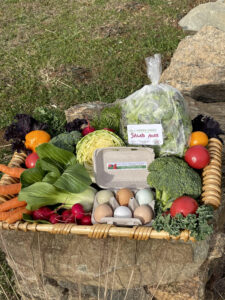 Maxine, you cover the reasons for knowing exactly where one’s food comes from beautifully, clearly, and concisely in your excellent book, There’s A Cow In My Freezer. The bottom line, as you aptly state, is that “not all meat is created equal”. In fact, I might go so far as to suggest that any food, protein or produce, sourced from a local farm that the customer can visit, inspect, and “know” is far superior to food from any other source. People are, in fact, omnivores. Humans have evolved throughout history to thrive on diets built on both flora and fauna. Furthermore, until recently along our historical timeline, people have evolved in specific localities eating traditional local foods. Their guts have been closely linked to the earth around them in an intimate and nurturing manner. That suggests strongly to me that we, and our developing families, may indeed need those nutrients and trace elements closely tied to where we live.
Maxine, you cover the reasons for knowing exactly where one’s food comes from beautifully, clearly, and concisely in your excellent book, There’s A Cow In My Freezer. The bottom line, as you aptly state, is that “not all meat is created equal”. In fact, I might go so far as to suggest that any food, protein or produce, sourced from a local farm that the customer can visit, inspect, and “know” is far superior to food from any other source. People are, in fact, omnivores. Humans have evolved throughout history to thrive on diets built on both flora and fauna. Furthermore, until recently along our historical timeline, people have evolved in specific localities eating traditional local foods. Their guts have been closely linked to the earth around them in an intimate and nurturing manner. That suggests strongly to me that we, and our developing families, may indeed need those nutrients and trace elements closely tied to where we live.
When you buy and eat local meat and produce, your know what you’re getting, how it was raised, what went into it, how it lived, and how your own biological ecosystem may be affected. Your diet becomes more nutrient-dense and immune-friendly. You have access to foods that taste like no other, with terroir like a fine wine. You get to be part of the process and decision-making and can feel confident that you’re taking charge of your health. You become more food-independent, since you now have someone who can support your needs during times of trouble or pandemic. You stretch your mind and sometimes your soul.
What do you consider some of the biggest challenges facing small family farms today?
There are many challenges facing small farms of any kind, not just family farms. Frankly, most of the farmers I come in contact with are newly beginning farmers like ourselves, and not family farmers. That in itself makes a statement: Family farms are in deep trouble since there is no career path under our current agricultural system for the younger generation.
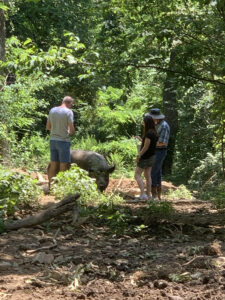 That said, these are some of the most challenging obstacles in my opinion:
That said, these are some of the most challenging obstacles in my opinion:
- Access to land: Land is incredibly expensive in most areas. Unlike in Europe and other parts of the world where towns and cities are clustered and farms supply specific localities, American lifestyles have created sprawling urban landscapes that gobble up land and raise land prices above what a farmer can afford.
- Barriers to entry: It is hard to get lenders to support farming activities. The saying goes that “the only way to make a million dollars by farming is to start with three million”. Infrastructure, equipment, livestock, land, supplies, seeds, labor … all very expensive and often difficult to find. It is incredibly difficult for folks to either keep up the family farm or start a new farm. Our food system and the general public’s willingness to pay for good food is just not supportive in our current American system.
- No career path for the next generation: This is pretty self-explanatory. The small farm may barely support one family, but it will struggle to support an extended family.
- Public misinformation: Not a single person visiting our farm has been able to correctly tell me the difference between grass-fed, grass-finished, organic, etc. foods. The public has a general, simplistic concept of what they think these things mean, but the margin for error is great.
- No unified voice for small farmers: We cannot compete with large commercial monoculture/mono-livestock farms. Both retail and wholesale customers want food at the lowest possible prices. Our socio-economic and political systems are set up to cater to large lobbies with lots of assets. Frankly, at the end of each day, we just fall into bed exhausted. There is little time to think about raising a voice, let alone to organize doing so.
- Unpredictability of the business model: There is one predictable thing about farming: it is incredibly unpredictable. Weather, reproduction, germination, predators, accidents, rustlers, pests, disease, customers, etc … all highly unpredictable influences. More than any other business, the small farm needs to know how to pivot on a dime despite the fact that most of what we raise and grow takes a long time to mature.
- Exhaustion: I won’t lie to you. There are days when I just don’t want to get out of bed. If we only had produce to tend to, I probably wouldn’t. But we don’t. Our animals need to be fed, watered, checked, vetted, bred, moved to new pastures, and socialized to human contact. And then there’s the rest of life (cooking, cleaning, bills, COVID, marketing, deliveries, relationships, taxes, etc.) that insists on demanding attention. It’s easy getting sucked into a spiral where you keep expending energy and forget to take time for yourself. There is always something critical that needs to get done.
What’s on the horizon for Hidden Creek Farm and Red Polls USA in 2021?
In the near-term, we will continue to build up our organic produce business, our organic and humane meat business, and our livestock breeding stock. We believe that Hidden Creek Farm can support about 150 to 200 ruminant “animal grazing units”, each unit equivalent to 1,000 pounds of live weight. We hope to close in on that number, between sheep and cattle, by the end of 2021. We are also focused on finishing our infrastructure development and becoming more energy independent. Our near- and long-term goal is to be known as the top-quality provider of safe, healthy, and delicious produce and meats — certainly in the Northern Virginia area and hopefully beyond.
We are also actively looking for partnerships with other farmers and with academic institutions to help develop superior breeding and meat stock, scaling quality delivery of products, and controlling the loose end of the farming business (i.e. the harvest of the animal that does not move into the breeding program). Currently Hidden Creek Farm has little control over quality of product once the animal is delivered to the harvest facility. We would like to be able to make sure that the care and attention to quality that we bring to raising our livestock continues during the harvest and packaging process.
On the produce side, we plan to quadruple our CSA sign-ups and wholesale customer base, as well as our partner drop-off locations, which will help drive business into our community stores. On the protein side, we will be offering 25-pound and 50-pound meat boxes in addition to the whole and half animals we currently market. On the Red Polls USA front, in 2021 we will continue building our herd and selling Salmonella– and E. coli-resistant bulls to interested cattlemen and cattlewomen both in the Red Poll community and for hybrid vigor in the non-Red Poll community.
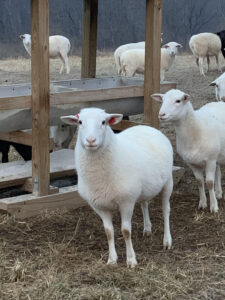
![]() Hidden Creek Farm will be launching the websites www.katahdinsusa.com for sheep and www.tamalitsa.com for our pigs to actively market and provide a breeding and stocking resource to farmers and the food community at large. Hidden Creek Farm is committed to working with Virginia Tech’s SWAREC Ram Test program and with NSIP (National Sheep Improvement Program) to raise parasite-resistant sheep. In mid-to-late 2021 we will have the volume to offer locally pastured feeder and finishing stock to our customers, and in 2022 we will launch a partner/co-op program focused on providing Tamalitsa™ breeding stock to other breeders.
Hidden Creek Farm will be launching the websites www.katahdinsusa.com for sheep and www.tamalitsa.com for our pigs to actively market and provide a breeding and stocking resource to farmers and the food community at large. Hidden Creek Farm is committed to working with Virginia Tech’s SWAREC Ram Test program and with NSIP (National Sheep Improvement Program) to raise parasite-resistant sheep. In mid-to-late 2021 we will have the volume to offer locally pastured feeder and finishing stock to our customers, and in 2022 we will launch a partner/co-op program focused on providing Tamalitsa™ breeding stock to other breeders.
We also look forward to continuing our mentoring, research, and internship programs, as well as workshops and farm visits, COVID willing. These programs give us such joy and infuse us with energy. The sharing of discoveries and knowledge, and learning from others, is incredibly meaningful to Dendy and me.
We hope that in 2021 we will all be able to get back to some semblance of a “steady state”. What a crazy ride of a year 2020 was for everyone! All of us at Hidden Creek Farm are grateful for our wonderful families, friends, customers, neighbors, fellow passionate farmers, food advocates like yourself, and our community at large.
My 2021 wish: Stay safe, keep others safe, and please support your local small farmer, wherever you may be.
If you’re in the Delaplane area, be sure to check out the delicious, nourishing food and educational opportunities Hidden Creek Farm has to offer. (It’s a working farm that takes the bio-security of its livestock very seriously, so visits are by appointment only.) Their Facebook page also provides frequent updates about goings-on at the farm.
